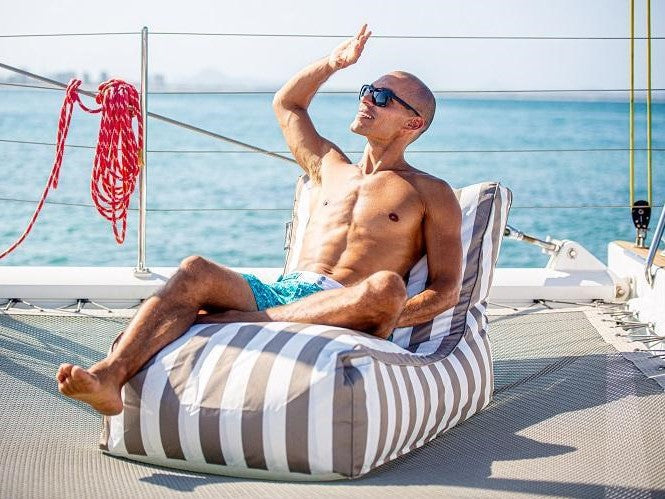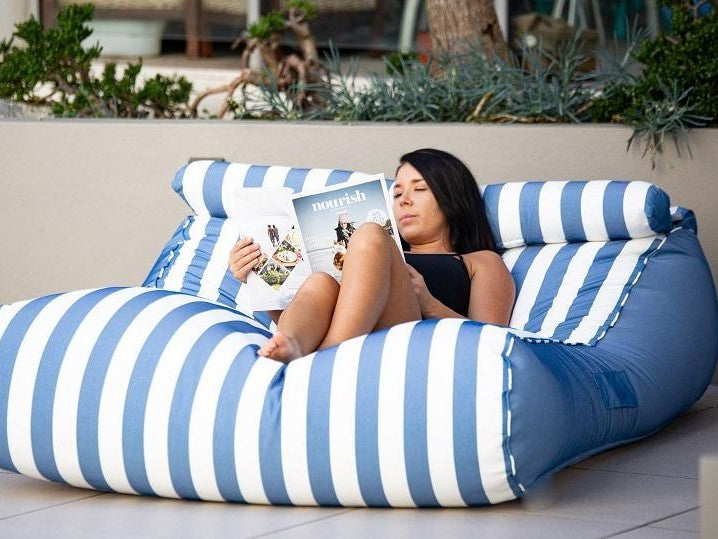The Ultimate Guide to Daybeds in Australia
This is the ultimate guide to daybeds. If you’ve ever questioned whether you should get a daybed, why they’re so great, or which daybed variety is the best, you’ll find all the answers in this article.
What is a Daybed?
If you’re wondering what the difference is between a daybed, a sofa, and a regular bed, you’re not alone.
Daybeds are basically sofa-bed hybrids. They combine the length and comfort of a normal bed with the headrest and positioning of sofas/couches. Unlike couches, daybeds are designed to accommodate a person lying down, but, unlike beds, they’re also intended for fully clothed, recreational usage – you can find them in living rooms and communal areas.
Daybeds have a very long history. In their first iteration, they were called klinai – wooden daybeds padded with cushions that wealthy Romans and Greeks used for eating, drinking and conversation.
During the 1500s, daybeds took on a new form: chaise lounges. These long, padded beds were developed to give French nobles a place to rest without retiring to the bedroom, and remained in vogue for the next few centuries. There were three main styles of chaise lounge:
- Duchesse brisée, a two-part lounge with a main chair and a footstool
- Récamier, a long lounge with two prominent ends and no sides, named after French socialite Juliette Récamier
- Méridienne, a reclining lounge with a high headrest and lower footrest
Although sofas (which developed from benches and chairs) became the seating of choice in the 20th and 21st centuries, daybeds remain a staple of interior design – they’re elegant, multipurpose pieces of furniture that look great both inside and outside houses.
What Does a Daybed Look Like?
Daybeds can vary hugely in design and style. Traditional daybeds are long enough that you can lie lengthways on them – double mattress width is standard. They also normally have headrests, a backboard along one side, plenty of padding, and wooden legs.
Ultimately, though, you can find daybeds in pretty much any material or shape. Some daybeds, like our Resort Byron Daybed and Resort Islander, are minimalist bean bag beds. Others have a more lounge- or chair-like style, with fixed wooden frames, padded cushions, and underbed drawers.
You can even find some luxury daybeds that feature canopies and curtains. We’ll leave you to decide whether that’s stylish or overkill!
Types of Daybeds
Outdoor Daybeds in Australia
Outdoor daybeds in Australia need to be two things: comfortable and durable. They need to be able to weather harsh Australian climates without fading, breaking or corroding, regardless of whether they’re exposed to 45-degree summer sun or torrential rain.
As such, you can find a few types of different daybeds designed for the outdoors, including:
- Rounded wicker daybeds with cushions
- Traditional bench-shaped wooden daybeds with cushions
- Resort-style recliner daybeds with mattresses and adjustable headrests
- Wooden pavilion daybeds with canopies and shades
- Bean bag daybed
Recommended Daybeds (Available Online)
Sure, we’re a bit biased, but these are our top picks for outdoor daybeds:
Hear us out.
All our daybeds are super comfortable, which is the most important thing, but they also have a bunch of other great features, including:
- Mould, UV, and abrasion-resistant olefin covers
- Patented Flowtex moisture removal system to prevent internal mould
- Inner cover to protect beads from moisture
- Hard-wearing Textilene base designed for outdoor use
- High quality material which is much easier to maintain and clean (bleachable and front loader machine washable)
- Light and easy to move around
- Some can float on the water - please contact us if you are unsure if your choice is capable of going in the pool (mush have a mesh liner to allow water to flow out and use standard large beans) - see link here to our pool bean bags.
- Extended 3 year warranty on fabric against fading and deterioration
- One of the largest range of colours on the market Custom designs - Contact us to order a specific or different colour You can even have corporate designs embroided on to promote your brand and look amazing!
- The best quality materials and workmanship so they will last for years and years - and still look amazing without fading or deteriorating. Most outdoor bean bags do not do this.
We even have Whisper-quiet Microbeans available as filling – they’re smaller than normal bean bag beads, which means they last longer, offer better support, and make significantly less noise. Importantly, our bean bags aren’t attractive to insects – spiders can’t build webs under them, and termites don’t chew olefin fabric.
Most traditional outdoor daybeds, by contrast, are hard to move, prone to environmental damage, and act as magnets for all sorts of nasties (including redbacks). They’re also made of wood or wicker, which means you can’t really sink into them and relax properly.
Is there anything wrong with your average outdoor daybed? Not really.
Are Epona Co. Lifestyle Bean Bag daybeds better? Yes, 100%.
Indoor Daybeds in Australia
Indoor daybeds are a great addition to most Australian homes. They’re versatile, they look nice, and they’re the perfect antidote to post-work exhaustion. The trick, of course, is deciding whether or not they’re better than a couch – and, if they are, which style of daybed works best with your interiors.
Couches or sofas occupy a prime position in most Aussie households because of their clear focus. A couch is made for sitting, and everything about it is optimised to make that experience as comfortable as possible.
In many cases, couches are also more practical. Modular and L-shaped couches are also very popular, especially in living rooms – their design makes them ideal for conversations or family movie nights.
So when is a daybed a good choice? Well, when you’ve got a specific style you’re going for, or when you want that extra flexibility. Wicker, cane and timber daybeds go great with certain aesthetics; they can also serve as affordable guest beds that don’t need to be packed away. Finally, some daybeds also have underbed drawers or storage areas – perfect if you’re space-restricted.
The benefit of using outdoor fabric inside is that if they sit against a window in the sun, they will not fade and deteriorate over time. Epona Co. Lifestyle Bean Bags are designed to last for years in the direct sunlight and will not fade.
Timber Daybeds in Australia
If you want classic, timber is for you.
Timber daybeds keep things simple with wooden legs, a wooden frame, and boarded sides, and can easily accommodate slide-out mattresses or underbed storage spaces.
Simple, white-washed timber can look great in plenty of different interiors. For a more sophisticated look, try pairing a dark-varnished timber with black fabric or leather cushions. Keep in mind, though, that darker colours are hotter – if you’re looking for an outdoor timber daybed, we recommend choosing white where possible.
Wicker & Cane Daybeds in Australia
The big disadvantage of wooden daybeds is that they’re heavy. All that timber makes them bulky and hard to shift, even with two people.
That’s why wicker, cane and rattan daybeds have become so popular. All three materials are strong but light, and can be woven into perforated frames that keep overall weight to a minimum. They also happen to look great, especially if you’re trying for a coastal or tropical vibe – natural wicker and cane have a classic beachside look, but, when painted white, they’re perfect for Hamptons-style homes too.
Wicker, cane and rattan daybeds normally have panels at both ends and one side. They’re often padded with a mattress and throw cushions. Wicker is however prone to moud and once set in, completely ruins the look and unhealthy to be around.
Pool Daybeds in Australia
Classic daybeds are designed laterally. When they’re pushed back against walls, they face outwards, with you lying along their length.
Most pool daybeds, by contrast, are more like long recliner chairs, and tend to position the occupant directly forward. It’s for this reason that they’ve become popular as poolside furniture across Australia, particularly at hotels and resorts.
Our Resort Lounger and Resort SunLounger are great examples of pool daybeds that balance comfort with practicality. Both bean bags position occupants in a near-zero gravity position, which optimises spinal alignment and blood flow. Like all our bean bags, they’re made out of high-quality olefin fabric (UV-, mould- and wear-resistant), and incorporate our patented Flowtex water drainage system, so it won’t matter if they get wet.
The Resort Lounger is wider and delivers a more bean bag-like experience; the Resort SunLounger is firmer and higher in the back, which is ideal if you enjoy reading, using your phone, or watching the kids while you relax.
Where Should You Put Your Daybed?
It’s the question on everyone’s minds: where exactly should I put my daybed? The versatility of the daybed is both a blessing and a curse, because it makes assigning it a place in your home hard.
If you’re buying an indoor daybed, consider positioning the panelled side of the bed against a wall in your loungeroom or communal areas. This maximises space and hides the daybed’s less aesthetic behind. Of course, you should always take advantage of any windows or views that you have – it’s hard to beat a cool breeze on your face when you’re dozing off.
Outdoor daybeds are a bit trickier. Unless you’re buying a sun-bathing or poolside daybed, shade should be a priority. Your daybed will be protected from the elements, and you’ll be able to enjoy some shuteye without getting sunburnt.
We normally recommend placing your daybed on your patio or deck, but, with an appropriately shaded garden, plonking it under a tree can be really nice. As with interior positioning, try and make the most of any breezy spots you have in your backyard – you’ll thank us when summer rolls around.
Finding the Right Daybed for Your Space
When you’re looking for a daybed, ask yourself these three questions:
Does it match my practical needs? Your daybed should be comfortable and durable, especially if you’re putting it outside.
Does it match my style? Don’t be that person who puts a 70s-style wicker daybed in a minimalist flat. Always match your daybed choice to your home.
Can I customise it the way I want? Certain daybeds lend themselves well to customisation. Timber daybeds, for example, can be painted, varnished, and decorated with a variety of cushions, mattresses, and rugs. Think about whether customisation is important to you – it can come in handy if you decide to change up your interior style in the future.
Summary
It’s OK, we get it: you’re hunting for your ideal daybed, and you don’t have time to read the whole article.
Here’s the TL;DR version.
- Daybeds are a cross between a bed and a sofa.
- They’ve been around since ancient Greece.
- They normally have headrests, a backboard along one side, plenty of padding, and wooden legs.
- Daybeds come in indoor and outdoor varieties.
- We have a range of premium outdoor bean bag daybeds available here.
- The most common types of daybeds are timber daybeds, wicker/cane/rattan daybeds, and pool daybeds.
- Put your daybed in a spot that maximises space, gets gentle breezes, and is shaded.
- Use our three-question checklist when investing in a daybed.
And that’s it! You’ve finished our ultimate guide to daybeds – well done. You now know more than most people about daybeds, and (hopefully) you’ve gained enough knowledge to make an informed decision when buying one.
Life’s Better in a Bean Bag!!
Happy shopping!

















